Telstra Bundle
How Does Telstra Thrive in the Australian Telecom Market?
As Australia's telecommunications giant, Telstra's financial performance in FY24, with a 3.7% income increase to A$11.7 billion, showcases its enduring strength. But how does this industry leader maintain its competitive edge? This analysis unveils the inner workings of Telstra SWOT Analysis, exploring its core operations and strategic initiatives.
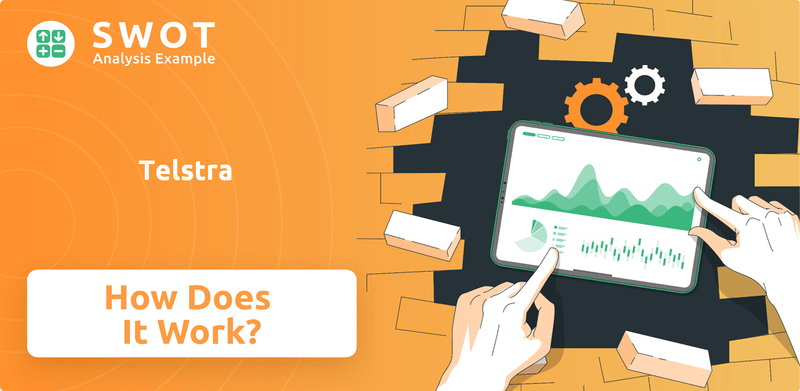
From its extensive Telstra network to its diverse Telstra services, understanding Telstra is crucial. Whether you're researching Telstra internet plans for home or exploring Telstra business solutions, this guide provides essential insights. Discover how this major player among mobile phone providers and internet service provider maintains its dominance in the Australian market, providing valuable information for investors and consumers alike.
What Are the Key Operations Driving Telstra’s Success?
Telstra creates and delivers value through its extensive network infrastructure and a comprehensive suite of telecommunications and technology services. These services are designed for both consumer and business segments. Its core offerings include mobile connectivity, fixed-line internet, voice services, data solutions, and a growing array of digital solutions and managed services for enterprises. The company serves a broad customer base, from individual consumers and small businesses to large corporations and government entities.
The operational processes underpinning these offerings are multifaceted. Telstra's operations are centered around its vast Telstra network, which includes mobile towers, optic fiber cables, and data centers. Technology development is continuous, focusing on enhancing network capabilities, such as the ongoing rollout of its 5G network and the expansion of its intercity fibre network. Logistics involve the deployment and maintenance of this infrastructure, ensuring widespread coverage and service reliability.
As of December 31, 2023, Telstra reported 26.3 million retail mobile services and 4.9 million retail fixed broadband services, demonstrating its widespread reach. Sales channels span retail stores, online platforms, and direct sales teams for enterprise clients. Customer service is delivered through various touchpoints, including call centers and digital self-service options. Telstra's supply chain involves sourcing equipment from global technology providers and managing a complex ecosystem of contractors for network deployment and maintenance. This robust infrastructure translates into customer benefits such as reliable connectivity, high-speed internet, and a wide range of integrated communication solutions, differentiating Telstra in a competitive market.
Telstra services include mobile, fixed-line internet, and voice services. They also provide data solutions and digital solutions for businesses. The company focuses on a broad customer base, including individuals, businesses, and government entities.
Operations are centered around its vast network including mobile towers and fiber optic cables. Technology development focuses on enhancing network capabilities, such as the rollout of 5G. Logistics involve deployment and maintenance of infrastructure.
Telstra serves millions of customers across Australia. Sales channels include retail stores, online platforms, and direct sales teams. Customer service is delivered through various channels, including call centers and digital self-service options.
Telstra's extensive ownership of critical infrastructure provides a significant competitive advantage. This infrastructure ensures reliable connectivity, high-speed internet, and a wide range of integrated communication solutions. This helps differentiate Telstra in the market.
Telstra's operations are unique due to its extensive ownership of critical infrastructure, providing a significant competitive advantage. This ownership allows for greater control over service quality and network reach. For more insights into their marketing strategies, you can read about the Marketing Strategy of Telstra.
- Extensive Network Infrastructure: Includes mobile towers, fiber optic cables, and data centers.
- Continuous Technology Development: Focuses on enhancing network capabilities, such as the rollout of 5G.
- Customer Service: Delivered through various touchpoints, including call centers and digital self-service options.
- Supply Chain Management: Involves sourcing equipment from global technology providers.
Telstra SWOT Analysis
- Complete SWOT Breakdown
- Fully Customizable
- Editable in Excel & Word
- Professional Formatting
- Investor-Ready Format
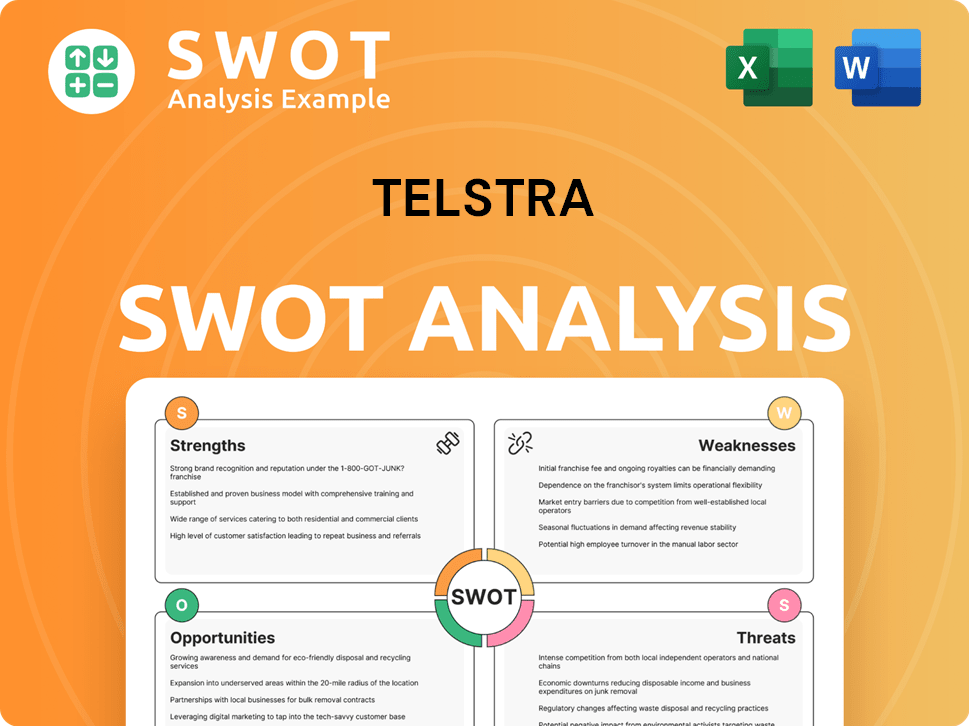
How Does Telstra Make Money?
Understanding the revenue streams and monetization strategies of Telstra provides insight into its financial health and market positioning. The company has a diversified approach, catering to both consumer and business segments within the Australian telecommunications landscape. This strategy allows Telstra to capture value across various services.
Telstra's revenue is primarily generated from mobile services, fixed broadband, enterprise solutions, and wholesale services. Analyzing these streams reveals how Telstra adapts to market changes and maintains its competitive edge. For the half-year ended December 31, 2023, Telstra reported a total income of A$11.7 billion, showcasing its significant market presence.
Telstra's monetization strategies involve tiered pricing, bundled services, and wholesale offerings. These approaches aim to increase customer loyalty and maximize revenue per user. The company's focus on high-growth areas like network applications and digital solutions demonstrates its commitment to evolving with the digital transformation.
Mobile services, including post-paid and pre-paid plans, are a major revenue source. The 4.1% increase in mobile services revenue for the half-year FY24 highlights its importance. Telstra offers various mobile plans to cater to different customer needs, making it a key player among mobile phone providers.
Fixed broadband and voice services contribute significantly, including NBN resale and services on Telstra's network. These services are essential for residential and small business customers. Telstra internet plans for home are a key offering in this segment.
Enterprise solutions, including data, IP, and managed services, are crucial for larger businesses. Telstra business solutions provide tailored services to meet the complex needs of corporate clients. The 10.9% increase in NAS revenue in the first half of FY24 shows growth in this area.
Telstra uses tiered pricing for mobile and broadband, offering different data allowances and speeds. Bundled services, combining mobile, internet, and entertainment, increase customer retention. Wholesale services to other providers also generate revenue.
Telstra leverages its extensive infrastructure to offer wholesale services. This includes providing network access to other telecommunications providers. This approach allows Telstra to maximize the value of its infrastructure investments.
Telstra is shifting toward high-growth areas like network applications and digital solutions. This strategic move aims to capture value from the digital transformation of its customers. This approach is part of a broader strategy to move beyond traditional carriage services.
Telstra's revenue streams and monetization strategies are designed to ensure sustainable growth and adapt to the evolving telecommunications market. The company's focus on mobile, broadband, and enterprise solutions, combined with strategic pricing and bundling, positions it for continued success. For more insights, you can explore the Growth Strategy of Telstra.
- Mobile services, including post-paid and prepaid plans.
- Fixed broadband and voice services for residential and small business customers.
- Enterprise solutions, offering data, IP, and managed services.
- Tiered pricing for mobile and broadband plans.
- Bundled services to increase customer stickiness and ARPU.
Telstra PESTLE Analysis
- Covers All 6 PESTLE Categories
- No Research Needed – Save Hours of Work
- Built by Experts, Trusted by Consultants
- Instant Download, Ready to Use
- 100% Editable, Fully Customizable
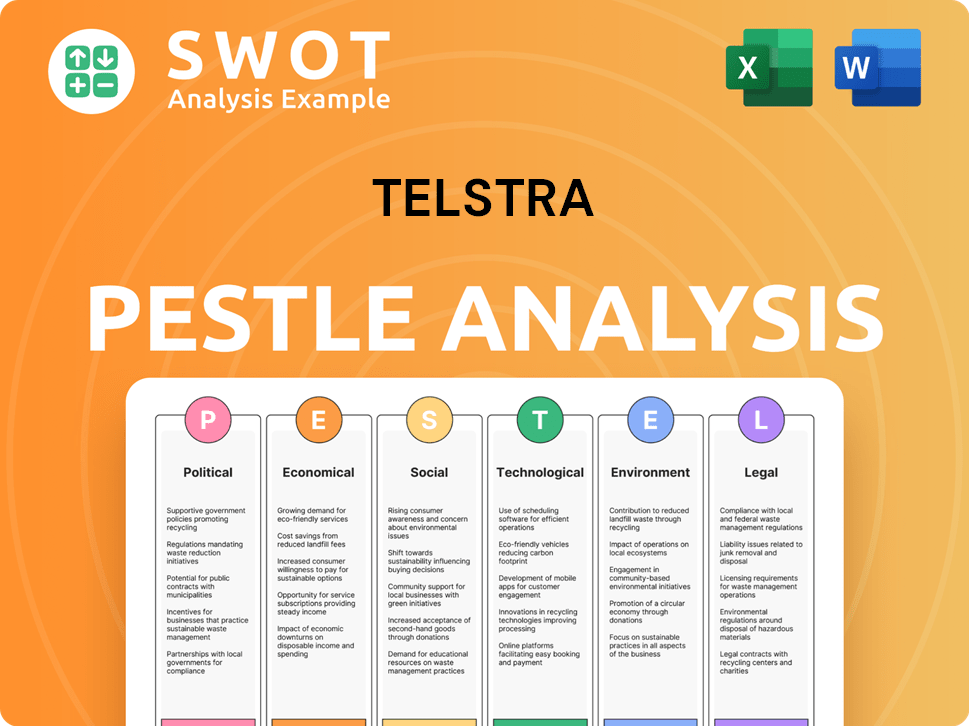
Which Strategic Decisions Have Shaped Telstra’s Business Model?
The evolution of Telstra has been marked by significant strategic moves and key milestones that have shaped its operational and financial landscape. A major focus has been on the rollout of 5G technology. This investment has significantly enhanced its network capabilities, positioning it at the forefront of mobile connectivity in Australia. Complementing this is the expansion of its intercity fibre network, a strategic move designed to boost data capacity and resilience across the country. These infrastructure investments are vital for maintaining its competitive edge in a data-intensive world.
The company has navigated operational challenges, including intense market competition and the complexities of the NBN rollout. It has adapted its business model to a post-NBN environment, acting as a major retail service provider. Telstra's competitive advantages are multifaceted, with a strong brand built over decades as Australia's incumbent telecommunications provider, fostering significant customer loyalty. Its extensive network infrastructure, unparalleled in Australia, provides technology leadership and economies of scale, allowing it to offer superior coverage and reliability.
Telstra's integrated ecosystem of services, combining mobile, fixed-line, and digital solutions, creates a sticky customer base and opportunities for cross-selling. The company continues to adapt to new trends and technology shifts, such as the increasing demand for cloud-based services and cybersecurity solutions, by expanding its enterprise offerings and strategic partnerships to address evolving market needs. Understanding the ownership structure is crucial; more information can be found in this article about Owners & Shareholders of Telstra.
Telstra's journey includes significant investments in 5G technology, enhancing its network capabilities. The expansion of its intercity fibre network is another key strategic move. These investments are vital for maintaining its competitive edge in a data-intensive world.
Adapting to the post-NBN environment, Telstra has become a major retail service provider. It focuses on expanding enterprise offerings and strategic partnerships. This allows it to address evolving market needs, such as cloud-based services and cybersecurity solutions.
Telstra's strong brand fosters customer loyalty, built over decades. Its extensive network infrastructure provides technology leadership and economies of scale. The integrated ecosystem of services creates opportunities for cross-selling.
In recent financial reports, Telstra has shown a commitment to returning capital to shareholders. For example, in the first half of FY24, Telstra declared a fully franked interim dividend of 8.5 cents per share. The company's focus on operational efficiency and strategic investments in network infrastructure continues to drive financial results.
Telstra's strengths include its strong brand, extensive network, and integrated services. These factors contribute to customer loyalty and market leadership. The company’s focus on 5G and fibre infrastructure enhances its competitive position.
- Strong Brand Recognition: Decades of presence in the Australian market.
- Extensive Network Infrastructure: Unparalleled coverage and reliability.
- Integrated Services: Combining mobile, fixed-line, and digital solutions.
- Strategic Investments: Ongoing investments in 5G and fibre.
Telstra Business Model Canvas
- Complete 9-Block Business Model Canvas
- Effortlessly Communicate Your Business Strategy
- Investor-Ready BMC Format
- 100% Editable and Customizable
- Clear and Structured Layout
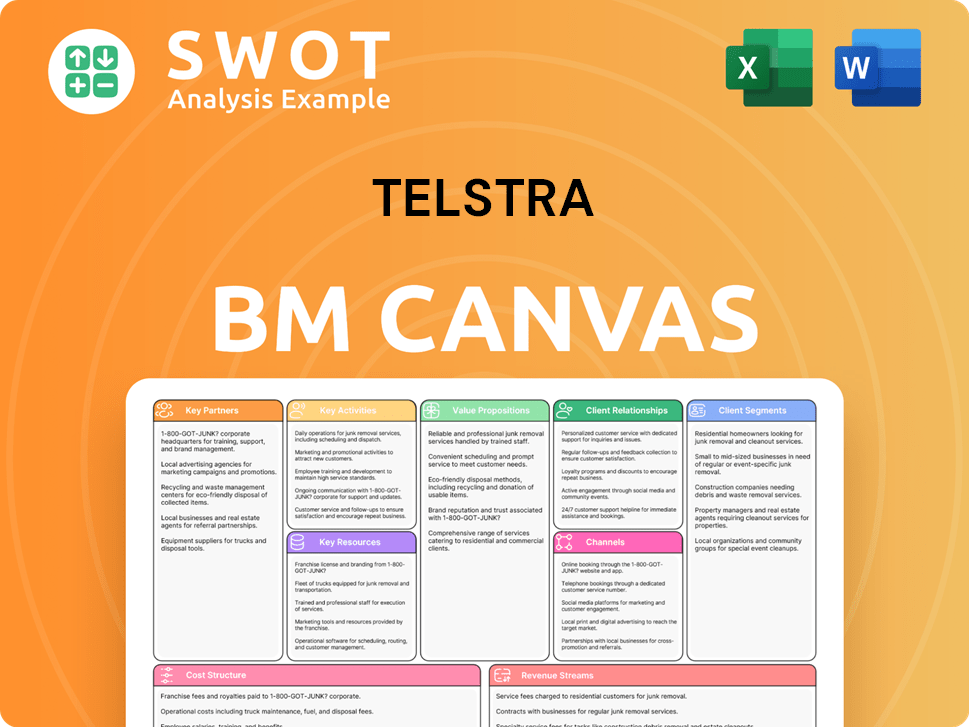
How Is Telstra Positioning Itself for Continued Success?
Telstra maintains a strong position in the Australian telecommunications market, primarily due to its extensive network and long-standing presence. As of December 31, 2023, Telstra reported a substantial customer base, including 26.3 million retail mobile services and 4.9 million retail fixed broadband services, reflecting its significant market share. Although it faces competition from rivals like Optus and Vodafone, its brand reputation and network quality support strong customer loyalty.
However, Telstra faces several key risks, including regulatory changes, intense competition, and technological disruptions. The company must continuously invest in innovation and network upgrades to address the emergence of new communication technologies and changing consumer preferences. Strategic initiatives are crucial for sustaining and expanding its profitability.
Telstra is a leading player in the Australian telecommunications sector, offering a wide range of services. Its extensive infrastructure and brand recognition contribute to its strong market position. Telstra's services include mobile, broadband, and other communication solutions.
The company faces risks from regulatory changes, such as spectrum allocation rules. Intense competition in mobile and broadband can pressure pricing. Technological advancements and changing consumer behaviors require continuous innovation and adaptation for Telstra.
Telstra focuses on strategic initiatives to ensure future profitability, including its T25 strategy. Investments in 5G and fiber networks are ongoing to support future data demands. The company aims to leverage technology and expand into new areas like IoT to drive growth.
Telstra offers a comprehensive suite of telecommunications services, including mobile, fixed broadband, and enterprise solutions. Its customer base is substantial, with millions of subscribers across various service categories. The company's market share reflects its strong position in the Australian telecommunications landscape.
Telstra is focused on strategic initiatives to sustain and expand its profitability, including its T25 strategy, aiming for continued growth. The company actively invests in its network infrastructure, particularly the 5G rollout and intercity fiber network expansion. These initiatives are designed to support future data demands and capitalize on the increasing digitalization of the economy.
- Continued investment in 5G network expansion.
- Expansion of intercity fiber network.
- Focus on improving customer experience.
- Exploration of new revenue streams, such as IoT.
Telstra Porter's Five Forces Analysis
- Covers All 5 Competitive Forces in Detail
- Structured for Consultants, Students, and Founders
- 100% Editable in Microsoft Word & Excel
- Instant Digital Download – Use Immediately
- Compatible with Mac & PC – Fully Unlocked
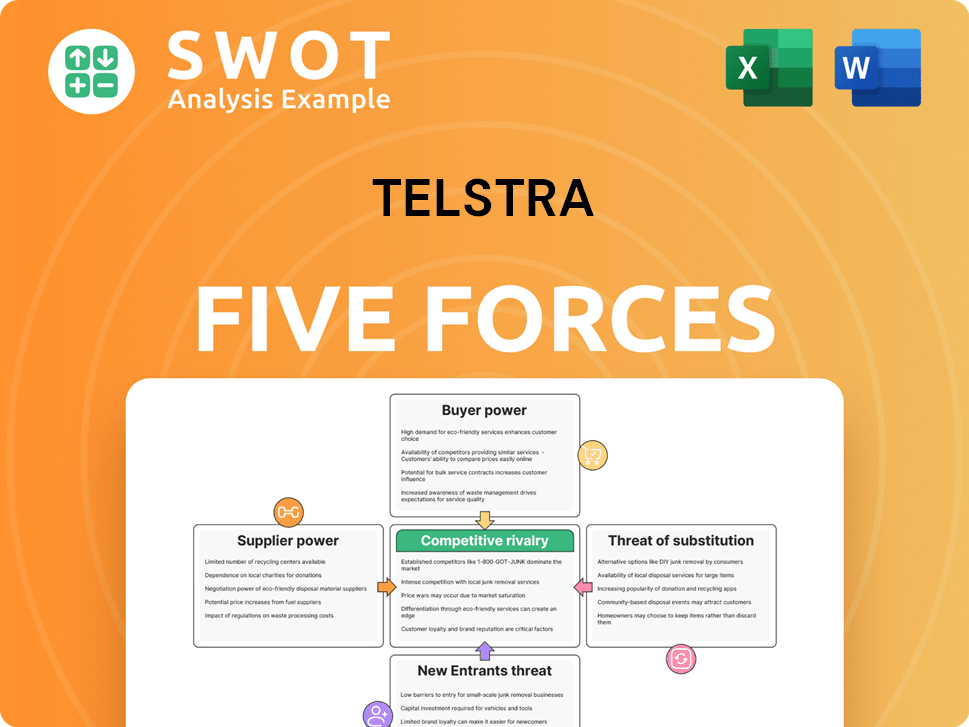
Related Blogs
- What are Mission Vision & Core Values of Telstra Company?
- What is Competitive Landscape of Telstra Company?
- What is Growth Strategy and Future Prospects of Telstra Company?
- What is Sales and Marketing Strategy of Telstra Company?
- What is Brief History of Telstra Company?
- Who Owns Telstra Company?
- What is Customer Demographics and Target Market of Telstra Company?
Disclaimer
All information, articles, and product details provided on this website are for general informational and educational purposes only. We do not claim any ownership over, nor do we intend to infringe upon, any trademarks, copyrights, logos, brand names, or other intellectual property mentioned or depicted on this site. Such intellectual property remains the property of its respective owners, and any references here are made solely for identification or informational purposes, without implying any affiliation, endorsement, or partnership.
We make no representations or warranties, express or implied, regarding the accuracy, completeness, or suitability of any content or products presented. Nothing on this website should be construed as legal, tax, investment, financial, medical, or other professional advice. In addition, no part of this site—including articles or product references—constitutes a solicitation, recommendation, endorsement, advertisement, or offer to buy or sell any securities, franchises, or other financial instruments, particularly in jurisdictions where such activity would be unlawful.
All content is of a general nature and may not address the specific circumstances of any individual or entity. It is not a substitute for professional advice or services. Any actions you take based on the information provided here are strictly at your own risk. You accept full responsibility for any decisions or outcomes arising from your use of this website and agree to release us from any liability in connection with your use of, or reliance upon, the content or products found herein.